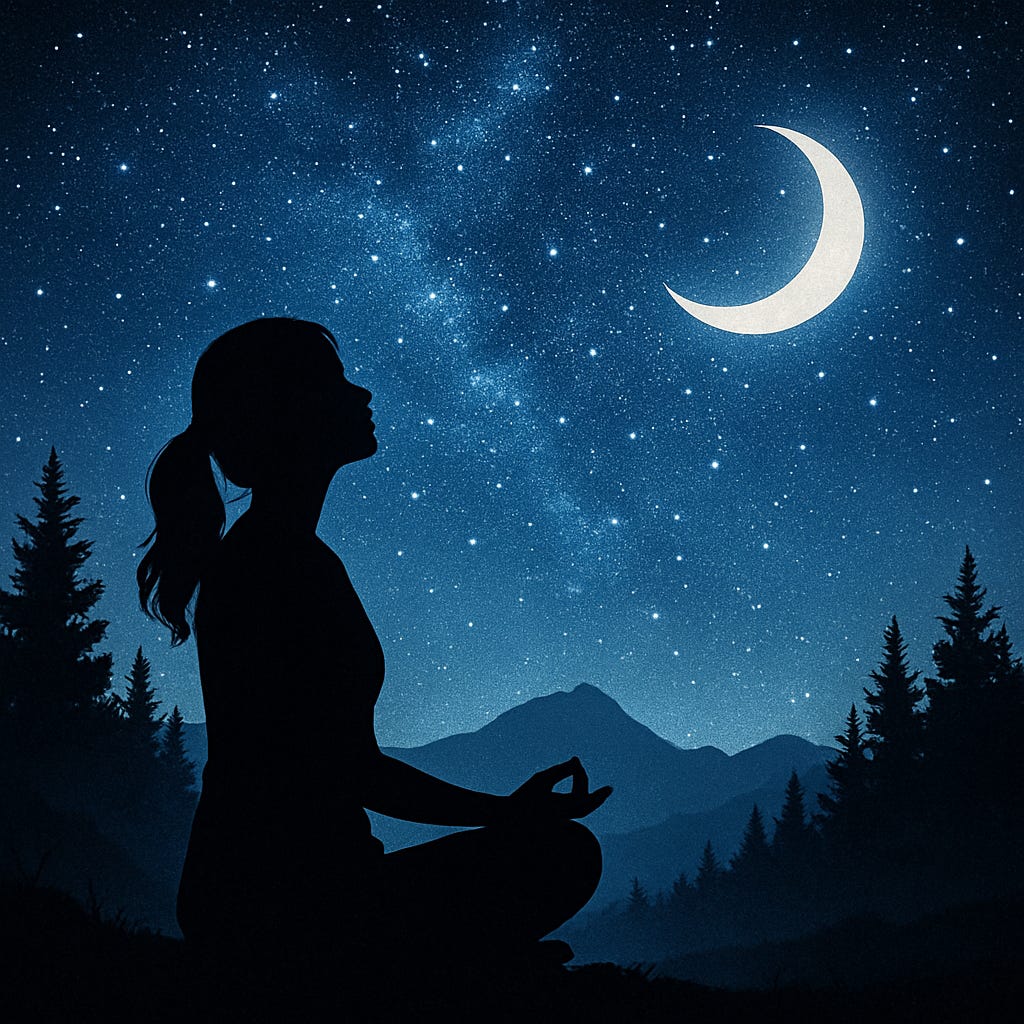I’m Not Triggered is on YouTube! Watch this episode here!
“If your parents’ faces never lit up when they looked at you, it’s hard to know what it feels like to be loved and cherished. If you come from an incomprehensible world filled with secrecy and fear, it’s almost impossible to find the words to express what you have endured. If you grew up unwanted and ignored, it is a major challenge to develop a visceral sense of agency and self-worth.”
— Bessel A. van der Kolk, “The Body Keeps The Score”
Have you ever driven home and realized you don't remember the journey?
Found yourself nodding along in a conversation while your mind was somewhere else entirely?
Reached for your phone for just a minute and suddenly lost an hour?
Yeah, me too. All the time.
These moments of autopilot aren't just annoying little glitches in our day – they're symptoms of what I've come to understand as mindlessness. And for those of us with trauma, depression, anxiety, or just living in this chaotic world, mindlessness can become our default setting.
That's why today I want to talk about mindfulness – what it actually is, why the science behind it is genuinely revolutionary, and how finding your own personal approach to mindfulness might be the most important gift you ever give yourself.
What Is Mindfulness, Really?
When Marsha Linehan developed Dialectical Behavior Therapy (DBT), she placed mindfulness as the foundation everything else is built on. But here's the thing – mindfulness existed long before DBT.
Buddhist meditation practices have cultivated mindful awareness for over 2,500 years. When Jon Kabat-Zinn brought mindfulness into Western healthcare in the 1970s, he defined it simply as "paying attention in a particular way: on purpose, in the present moment, and non-judgmentally."
At its core, mindfulness is about showing up for your own life instead of missing it while your mind time-travels to the past or future.
The Science: This Isn't Just Feel-Good Fluff
I used to roll my eyes at the whole mindfulness trend. But then I started looking into the research, and honestly, I was stunned.
Sara Lazar's research team discovered that the amygdala (our brain's alarm system) actually shrinks with regular mindfulness practice, while the prefrontal cortex (responsible for higher-level thinking and emotional regulation) becomes thicker and more connected. This neurological restructuring helps explain why mindfulness improves our ability to respond rather than react.
Beyond brain structure, Richard Davidson's work at the University of Wisconsin-Madison has shown that mindfulness shifts our baseline brain activity from right-prefrontal (associated with negative emotions) toward left-prefrontal (associated with positive emotions).
The physiological impacts extend beyond the brain. Research published in the Journal Brain, Behavior, and Immunity found that 8 weeks of consistent mindfulness practice reduces the expression of genes involved in inflammation – potentially explaining why mindfulness practices have shown benefits for conditions ranging from chronic pain to autoimmune disorders. Eight weeks! That is such a short period of time when I think about how long I’ve been suffering.
For trauma survivors specifically, Bessel van der Kolk's groundbreaking work explains how mindfulness helps reconnect us with our bodies and the present moment – essential for healing when trauma has fragmented our sense of self and safety. (As an aside, van der Kolk wrote the book “The Body Keeps The Score” and it’s a very easy, incredibly enlightening read on how our physical bodies hang on to emotional and mental trauma and wounds. Totally worth reading!)
The Consequences of Running on Autopilot
Before I started practicing mindfulness, I spent most of my life either ruminating about the past or anxiously planning for every possible future disaster. Meanwhile, my actual life was happening, and I was missing it. And somehow, while missing my life, it also constantly felt like I was white-knuckling it most of the time.
This mindlessness isn't just philosophical – it has real consequences:
Our relationships suffer when we're physically present but mentally elsewhere;
Our work quality declines when we “multitask” instead of focusing (we can’t actually multi-task…at least, not well);
Our health deteriorates when we don't notice stress signals until we're completely burned out;
Our emotions control us when we can't recognize them until they've overwhelmed us;
Our joy diminishes when we can't fully experience positive moments.
For those of us with PTSD or trauma histories, mindlessness can be particularly dangerous. When we're disconnected from the present, we're more vulnerable to our triggers, emotional flooding, and maladaptive coping mechanisms (like self-harm, acting out, drinking, and isolating).
Finding Your Own Mindfulness Practice
Here's what took me years to learn: there's no singular right way to practice mindfulness. The cross-legged meditation you see on magazine covers? That's just one approach.
Mindfulness can take countless forms:
In DBT group therapy, we began each session with a short mindfulness activity. Those two words together seem like oxymoron at first, but once we understand that mindfulness is more about being present for what is and not at all about doing it correctly, I began to see that I could practice mindfulness with things I really enjoy!
For instance, sometimes we began with coloring pages. We may not finish the activity we started, but finishing wasn’t the point. Simply coloring was.
I love making music - I’ve been doing nearly everyday for about 2 years now or so and it brings me so much joy, so much curiosity and wonder, so much irritation and growth, so much personal confidence in my own abilities and choices. I never stopped to consider that mindfulness can be fun.
For me, mindfulness is: reading. Playing my drums or guitar. Songwriting. Working on my Substack and YouTube content.
No formal meditation here - these are all activities - done with purposeful intention and attention.
Mindful walking, focusing on the sensation of your feet touching the ground;
Deep listening to music, following individual instruments;
Flow states during creative activities like painting or writing;
Body-scan practices that call for attention through physical sensations;
Brief "micro-practices" like feeling three full breaths during transitions;
Watching the world around me while at a stoplight instead of my phone.
The key is experimentation; What helps you feel more present in your body and connected to the moment? That's your practice.
If you’re not sure where to start, I’d say begin with asking yourself what’s important to you right now and what activities can you pair with mindfulness to make the practice itself more rewarding initially.
The Hard Truth About Mindfulness
I won't sugarcoat this: mindfulness isn't always comfortable. Sometimes being present means facing difficult emotions instead of numbing them. It means noticing thought patterns you've relied on for years. It means sitting with uncertainty instead of desperately seeking escape.
For me, when the urge to self-harm come barreling at me at full speed, I often still find myself wondering if I will make it through that urge - or if the urge will make its way through me. As I’ve practiced being more mindful of my emotional state, I’ve been able to reduce the urges to self-harm significantly (though, not yet entirely).
This discomfort is precisely why mindfulness is so powerful for healing. When we can observe our thoughts and feelings without immediately reacting to them, we gain a crucial space – what Viktor Frankl called "the space between stimulus and response." In that space lives our power to choose differently.
Mindfulness researcher Jon Kabat-Zinn emphasizes that mindfulness isn't about eliminating negative emotions – it's about changing our relationship with them. We learn to witness our thoughts and feelings without being controlled by them. Kabat-Zinn’s website states,
“The regular practice of mindfulness can help you to realize (in the sense of make real) that in this very moment, you are whole, and at the same time, part of and interwoven into larger and larger circles of wholeness. Your own wholeness (the root meaning of the words health, healing, and holy) is a reflection of your truest nature, in other words, who you actually are in this timeless moment we call now, underneath all the thoughts and emotions, the ceaseless narratives, the times of turbulence and trauma, of stress, pain, illness, and uncertainty.”
Starting Simple
If you're thinking "this sounds great but impossible for me," I get it. That's exactly where I started. Here's what helped:
Use everyday activities as mindfulness triggers (brushing teeth, waiting in line, walking outdoors, breathing);
Set gentle reminders on your phone to check in with yourself (Apple has a built in app on the iPhone called “State of Mind” (which I think was previously just the mindfulness app);
Expect your mind to wander – that's not failure, it's normal;
Practice self-compassion when you notice you've drifted;
Find an anchor – breath, sounds, physical sensations – to return to.
Remember: mindfulness is a skill, not a talent. And like any skill, it improves with practice, not perfection.

A Final Thought
Mindfulness isn't about reaching some perfect zen ohmmm state where nothing bothers you. It's about showing up for your whole life – the messy, beautiful, complicated reality of it.
In my experience, the real magic of mindfulness isn't some dramatic transformation – it's in the small moments. Truly tasting your coffee. Really seeing the person you love. Feeling the sun on your face and actually noticing it.
These moments might seem insignificant, but they're the stuff life is made of. And when we miss them, we miss everything.
I challenge you to find just one moment each day to be fully present. Notice what happens. What works for you? What challenges arise? Remember, we're all figuring this out together.
"Be where you are, otherwise you will miss your life."
— Buddha
Resources for Deeper Learning:
Books: The Miracle of Mindfulness by Thích Nhất Hạnh, Wherever You Go, There You Are by Jon Kabat-Zinn
Apps: Insight Timer (free), Headspace, Calm
What's your experience with mindfulness? Reply to this email or leave a comment and let me know – I read every response!


